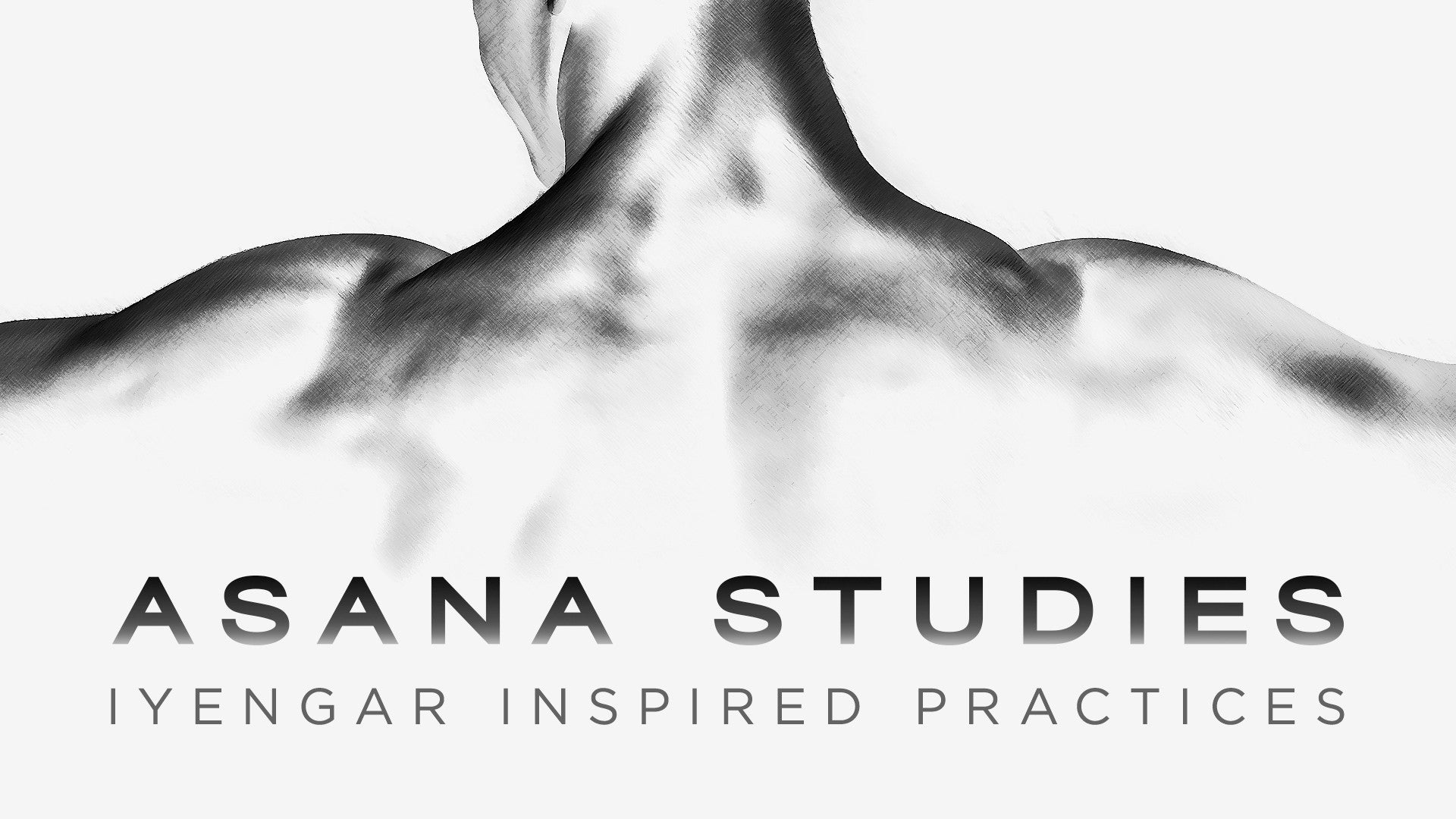Description
About This Video
Transcript
Read Full Transcript
(lapping waves)
In this kind we just go through the space closest to the belt and then back through the space of the buckle. And then tighten it up so that when you hold it in two fingers, you wanna measure just a little wider than your outer upper arm. Maybe I'll make mine a little tighter. Okay. So you have that all set. You can lay that aside, we'll use it later.
Come to all fours on your mat. Place your hands so the fingers are facing forward and make just a really light open thumbed hand position. Not like jazz hands or crazy stretchy hands, just soft with the thumbs turning toward each other a bit. And then come into this all fours position and find a sense of length through your crown of the head moving forward through the tailbone and also a sense of width and breath. Look for what we call in Yoga a neutral spine.
And that means it's not a back bend and not a forward bend. It's kind of hard to find but trust that it's right there for you. This line that's moving through your central axis. And now you're just gonna move not your spine but your arms and legs. I call this porch glider.
So moving forward and moving back and not at all changing the shape of the spine. So you're really articulating the arms and the shoulder socket and the thighs and the hip socket. Once you get a sense of that and it's not movement in the spine and that could take some time and some attention, you want to go forward and then roll it, make a circle. One direction, do it a couple of times and while we are doing this there's quite a shift of weight through your hands. So go back to porch gliding just straight forward and back so you'll notice that when you go forward there's more weight through the fingerprints and then when you go back there might be more of a sense of weight in the heel of the hand so try to keep your whole hand on the floor but just take note you wanna sort of chart how weight is moving through your hands.
And firm the pad of the thumb and the root of the index finger down onto the floor. Those points tend to get a little light so you wanna keep them grounded. Okay. And then knees together, sit back on your heels comfortably, shake the hands out. And we'll do the same thing again. All fours.
But this time you're gonna just spin your fingers so that they're facing your knees. So with your left hand you turn the hand like a counterclockwise dial so the fingers are facing your knees and do the same on the other hand and you'll know very quickly if this is possible for you or not. So you just turn the hands as far as you can, keeping your wrists as wide as your shoulders and then we go back into the porch gliding forward and back, and you'll notice right away that perhaps you don't have as wide a range of movement. Porch gliding and then circle in. Free the groin.
Shift the weight. Firm the fingers and the pads into the floor. And breathe. And then come center and sit back on your feet and roll the wrists, make some movements with your hands one really nice thing to do is kind of stir your fingers as if you had a bowl of rice right in front of you. Dry rice.
Not wet gloopy rice. And you shake your hands out. Okay. So grab one of your blocks and sit in Virasana on your block. And take your hands to your collarbones, and just notice how the collarbones, the shape of the collarbones, the length of your collarbones on your body so you feel.
Fingers to the collarbones, tracing out. They go how wide? They go right into the arm bone. So we're gonna commit to keeping your collarbones wide. Release your arms, keep your collarbones wide.
Bring your hands right out in front of you and then turn your fingers towards the ceiling, and open your thumbs just a bit, and extend the elbows and look at the shape between your collarbones your two long, straight arms and your thumbs. Be careful that when you take the arms forward you don't lift the shoulders because this changes the width of the upper chest. So collarbone's wide, arms long. This is a rectangle as if your thumbs could come together like collarbones, right? We're gonna take this shape and play with this shape.
So come back to all fours. Come to all fours. Two straight arms wide collarbones and your thumbs are really set clearly on the floor. Curl your toes under, take a breath in. As you exhale just lift your knees an inch off the floor, commit to the shape between your collarbones, your arms and your thumbs and lift your hips up.
Now it gets a little tough. Right? So you wanna turn the hand down but keep the sense of this rectangle that you're making. And then slowly let your legs extend back. Begin to take the hips back in space. Keep the collarbones wide the thumbs planted and the arms straight and you're just turning this rectangle in space.
And then bend your knees, relax your feet shake your hands out. Do it again. Hands on the floor. Find the rectangle. Curl the toes under.
Lift your hips up. The rectangle pulls back in space the minute that you bend an elbow or shorten your collarbones you kind of collapse onto the chest, you've lost the sense of a rectangle. Breathing, make the space lively so we're not gripping to find the shape, we're just playing with perhaps a new circuitry of energy, moving with right angles collarbones into arms. Stay steady in your Downward Facing Dog it should not be that you're hanging on the collarbones which we sometimes do, this is very broad in the front chest. Do tune your front lower ribs in away from the floor.
Then bend the knees. And come down. And shake your hands out. This is a nice one to do because it gets wristy a little bit so just place the backs of the hands on the floor for a moment and let the wrists spread put some weight into your finger bones your hand bones Okay. We'll go again with that sense of a very broad front chest and long arms.
Come to all fours. Curl your toes under. Come to Downward Facing Dog with this commitment to this sense of a rectangle that your head can move through tune the front lower ribs in but widen the chest and come into the truth of your pose, the clarity of it and then inhale bring your head through and come to plank a sense of a wide, open front chest. Bend the knees to the floor, relax the tops of the feet, and look forward. Bend your elbows straight back, wide collarbones, look forward and bring your chest to the floor.
And then lengthen your legs long, and bring your forehead to the floor. I won't because I can't talk if I do. So I'll keep my head lifted but you can rest your head so you're not using your neck right now. And curl your toes under and start walking your toes towards your chest, like you can snuggle all ten toes onto the floor. Stay there.
Reach your heels back. Let the reach of the heels pull the buttocks flesh long. And let the bottom edge of the sit bones so that buttocks line widen and let the buttocks drop down so the sit bones drop almost as if you could set your sit bones on the backs of the thighs. Thighs are lifting and reaching with the heels, buttocks is long sit bones are dropped. You really should feel this in your thighs, your front thighs.
And then lengthen the toes long, press your hands down, come through Cobra, pull the hips back and rest in Child's pose, and you can bring the backs of the hands on to the floor. And take a rest. A momentary rest. Back to all fours. Okay.
Same thing, you don't wanna lose what you had, you want to start superimposing everything we're talking about into the whole of Chaturanga Dandasana. So, all fours. You have this sense of this kind of inner rectangle and now we're gonna work on the outer rectangle, so from the pinkie to the outer upper arm, find that line, so you have the inner rectangle, collarbones, thumbs. And then you have the pinkie set, wrap the outer upper arm flesh right here, so that sort of outer deltoid back. Then curl the toes under.
Exhale, contain the rib cage so you still have your neutral spine. Anchor down through the pad of the thumb, the index fingers, feel the pinkies and the outer upper arms hugged back and then lift the knees up. Change the shape of that rectangle and now you have both sides of the arms moving back with the collarbones widening and almost rolling forward. But you don't wanna reach them off the back, they have to stay contained. And then stamp your hands into the basement, feel a lift through the rib cage and openness in the back lungs and breathe.
And then as you inhale the head comes through the space of the arms forward to plank. And stay in plank and find that same kind of stepping into the toes that we found when we were laying our belly on the floor. Reach the heels back, engage the quads, burnish them, sort of sear the front quad into the bone. And then release the sit bone, and take the head forward. Bend the knees come back and sit on your shins and gather your two blocks and place them in the middle of your mat right next to each other so you're making a platform for your thighs, so give yourself enough space forward so you can come to plank.
Alright? So come forward create your lines the inner rectangle and the outer rectangle which really connects to the shoulder blades to the pinkies, collarbones to the thumbs, and you're here. When you're clear, you're on your knees and then you curl the toes under and why don't we lift right into Downward Facing Dog. Outer upper arm bone back collarbones wide so I hope what you feel is a much more supported Dog that the collarbones are there to help you breathe and so are the shoulder blades and you wanna feel the space between the collarbones and the shoulder blades so just let the head go. And then inhale, charge forward, find that long neutral spine, keep the toes curled under and then you bend the knees find your blocks with your thighs.
Bend your elbows, you can bring your chest down to the floor, don't move your hands. Keep the toes curled under. Alright, it's not that great a place to stay, but you get to feel that your butt is loose and your sit bones are just like hanging out. Press your toes down, reach your heels back, let the heels pull the sit bones long, let the heels pull the sit bones long so you have the possibility to press your hands down and come to like a chai-ran-gy here. Move a little bit, widen the collarbones, tag the elbows into the sides of the chest and then come down.
Relax everything. Pretty, right? (laughs) Okay. We're gonna do it again, because it's fun. So curl the toes under they're really set, all ten of them on the floor. Breathe in.
As you breathe out, heels go, calves go, shins go, quads go hamstrings go, thighs go sit bones go. I felt like I was inflating there, you wanna inflate the upper chest by the power of the legs now breathe in here let's go up to plank. Inhale, exhale. Thighs up, plank. Commit to the wide open rectangles pulling back to Downward Facing Dog.
Inhale, head comes through, plank. But start reaching those heels to tag the sit bones let the thighs come charge up the legs, reach the sit bones and come onto your chest. One more time heels pull, calves pull, legs pull, sit bones engaged, chest comes up. Inhale, exhale. Plank.
Keep the collarbones wide, shoulder blades open, thumbs and pinkies contain the front lower ribs. And bend the knees. And sit back on your heels. Okay. Next bit of fun.
Find your belt. You can remove the blocks, you don't need them anymore. Okay. You have the loop. So you're gonna place your arms in the belt.
I'm just gonna open my belt a little bit wider. Right over your elbows. All you wanna do is bend your arms and see where this belt is gonna be touching your rib cage. It's important that you don't get your breasts caught between the belt and your rib cage, so whatever kind of hauling up you need to do, actually it's more likely that you have to move the belt a little lower on your arms to clear your breasts but you still wanna catch some bit of your rib cage. Takes a little doing maybe but this is what we're gonna do.
So just gather that tail of the belt and lay it close to you on the floor and come back to all fours. So I'm going into Chaturanga. So here you are in Chaturanga, very broad in the chest. Look at your feet. Step on to the tops of your feet but keep your legs very straight.
Ankles hugging to the mid line, inhale, roll the collarbones up. Bring the face forward, keep thinking about your feet. Let's just step onto the toes, lift the hips move to Downward Facing Dog and come right away same thing. Inhale plank. Bend the elbows straight back, find the sling, use your other foot first, step the top of the foot down, Upward Facing Dog, two straight legs step onto the toes and Downward Facing Dog.
Come and rest. You can do that as many times as you like but don't hang out in the prop, give yourself maybe four times at the most. Because we tend to fall into the prop. And you don't actually learn the structure that you need because this so cool and fun to do. Alright, so we have one more fun thing to do.
Just reach forward and roll up your mat. Roll it all the way up. Thank you mat for guiding me. And you just take your mat away. And now take your blanket and place it on the floor.
You can do this next little bit in socks if you don't want to stand on your blanket and mop your floor with your blanket. Otherwise, you'll stand on your blanket, and you can come into an easy Tadasana, the legs don't have to be together. And then bend forward and place your hands on the floor and you can already bend your knees if you need to, you don't have to do this with straight legs. You wanna find this shape again, thumbs, this inner rectangle and the outer rectangle as your structure. That's really what you're working around.
Alright. So I'll show you once what we'll do. I'll show you twice. Watch where my head goes. Okay?
Those are basically, that's a jump back. The weird thing about a jump back is you don't go back. You actually have to go forward. You have to trust the space, and have a sense of forward thrust, more than a back thrust, the legs just go, you don't wanna think about them. If you actually jump back, it's like a 26 car pile up for your spine.
So get it out of your mind, that you're jumping back. Let's do it together, I'll try to talk you through it. Okay? So come to your easy forward bend, firm the hands, bend the knees, look more forward than you want to. Take a few bounces, breathe in, and as you breathe out you go forward where you're looking.
The elbows bend, lift up through the collarbones, push your hands down like you're coming to handstand. Because of course, when you learn how to do all this, then the next thing is obviously handstand. In the middle of the room. Let's do it again. Hands on the floor, inhale, look forward, exhale, bend the knees, go forward.
Upward face, now down, look how far forward my head is. (laughs) Okay? Do that a hundred times! Then you're done. Thank you! Namaste.
Asana Studies: Heidi Fokine
Comments
I'm so glad to hear that you found the "helpful hints" actually helpful : )
Thanks for writing!
xoxoHeidi
You need to be a subscriber to post a comment.
Please Log In or Create an Account to start your free trial.















